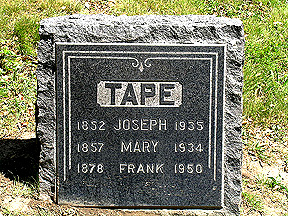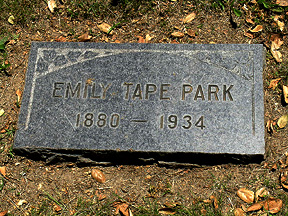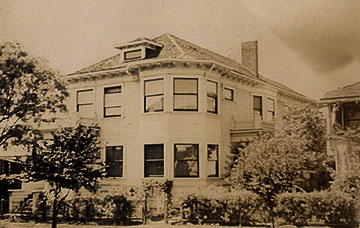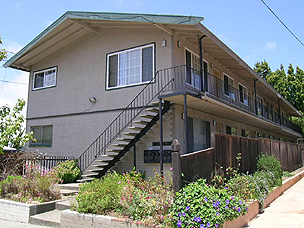The Tapes of Russell Street
An accomplished family of school desegregation pioneers
30 April 2004
Joseph, Emily, Mamie, Frank & Mary Tape circa 1884–85 (photo courtesy of Jack Kim and Loni Ding)
In 1895, a Chinese-American family by the name of Tape came to live at 2123 Russell Street in South Berkeley. They purchased a Queen Anne cottage newly built by William C. Bissell, a contractor who also dealt in real estate and insurance at 2050 Ashby Avenue, near Shattuck. Bissell had probably purchased the lot at auction in 1889, along with several others at the southern end of the Blake Tract. On 4 September 1894, he is said to have taken out a mortgage for improving the lot from the quaintly named Less Mortgage Citizens Bank and Loan. Two houses around the corner on Wheeler Street were built by him during the same period. One of those is a mirror-image twin of the cottage purchased by the Tapes.
The Tapes moved to Berkeley from San Francisco, where they had resided for over 25 years. A prosperous middle-class family, they no doubt wanted to own a home at a time when restrictive clauses in most San Francisco property deeds barred Chinese from occupying property outside Chinatown.
In 1896, the first year that the Tape name appeared in the Berkeley directory, Knox Presbyterian Church was established on the corner of Russell and Lorina Streets, directly across the street from the Tape house. Since the Tapes were Presbyterian, one would assume that they either settled on Russell Street because the church was being built there or were themselves instrumental in the establishment of the church in their new neighborhood.
“2123 in the olden days” (photo courtesy of Jack Kim)
Knox Presbyterian Church, original building (photo: Daniella Thompson, 2004)
It appears that Joseph Tape, who worked for the Southern Pacific Co. in San Francisco, heard about the new real-estate opportunities in Berkeley from his colleague John A. Brothers, who had purchased three lots on Russell St. near Fulton and in 1891 built a house at 2147 Russell Street.
Last but not least, it is more than likely that the Tapes chose to move to Berkeley because their youngest child was just then reaching school age, and San Francisco public schools were segregated. The Tapes cared deeply about racial equality and the right to education—so much so that they filed a landmark lawsuit against the San Francisco Board of Education ten years before they moved to Berkeley.
2123 Russell St. in 1939 (photo: Ormsby Donogh files, BAHA archives)
2123 Russell St., raised several feet (photo: Daniella Thompson, 2004)
Joseph C. Tape (1852–1935) and his wife Mary McGladery (1857–1934) were born in China and came to California in 1869 and 1868, respectively. Mary was an orphan (or an abandoned child) from the Shanghai area. At the age of eleven she was brought to San Francisco and spent the first five months in Chinatown before being taken up by the Ladies’ Protection and Relief Society, where she learned to speak English and acquire American manners. Established in 1853 and incorporated the following year, the Society ran a home for friendless or destitute girls aged two to fourteen and boys aged two to ten. In this home, located on Franklin Street between Post and Geary, the children were provided for until permanent homes in Christian families were secured for them.
The matron of the establishment was Miss Mary McGladery, whose name was adopted by the Chinese orphan girl. Mary remained in this home past the age of fourteen, according to her own testimony in a November 1892 interview with the San Francisco Call: “I staid with them five years or more and then met my husband.”
Joseph Tape (originally Chew Diep, Chew being the surname he inverted and anglicized into “Joe,” also using it for his middle initial) is said to have been educated at the Presbyterian Chinese Church and Mission (PCC) in Chinatown. Founded in 1853, PCC was the first Asian church in North America and the first Chinese Protestant church established outside China. However, Mae M. Ngai, a historian who has been researching the Tape family history for a number of years, found no evidence of Joseph Tape’s education. According to Prof. Ngai’s reconstruction, Joseph began his life in San Francisco as a houseboy at the home of Matthew Sterling, a Scottish-born metal assayer on Van Ness Avenue. Sterling apparently owned some cows, and Joseph delivered milk for him, reputedly on horseback. From here, he naturally progressed into working as a drayman. Following his marriage to Mary, Joseph went into business for himself. His express office was located at 704 Dupont Street (now Grant Avenue) in Chinatown. His firm had a monopoly on transporting Chinese who came to the U.S. in bond and handled large drayage contracts for wholesale merchants in Chinatown. He also engaged in bonding Chinese ships’ crew members. These were not allowed ashore unless they paid a bond to guarantee their departure from the U.S. Bonding was undoubtedly a lucrative occupation, since the overwhelming majority of crewmen on ships crossing the Pacific were Chinese. In addition to his expressing and bonding activities, Joseph was the interpreter to the Imperial Consulate of China in San Francisco.
Gertrude Ella Tape, early 1890s (photo courtesy of Jack Kim)
How Mary and Joseph met is not clear. Prof. Ngai believes that the proximity of Matthew Sterling’s home to the Ladies’ Relief Society’s orphanage facilitated their encounter. They might have met through the Presbyterian church. According to Joseph’s obituary in the Berkeley Daily Gazette, “both he and his wife were members of the household of the late Mr. and Mrs. Leland Stanford, who gave them their wedding.” The couple’s own testimony asserts that following a six-month courtship, they were married on 16 November 1875 by Rev. A.W. Loomis in the First Presbyterian Church (Rev. Loomis had ties to China and in 1867 edited the book Confucius and the Chinese Classics: Or Readings in Chinese Literature). The Tapes’ first daughter, Mamie (1876–1972), was born at their house on the corner of Gough and Vallejo Streets. Shortly thereafter they moved to Green Street between Gough and Octavia, and a year later to 1769 Green Street. During the following dozen years they had three more children: Frank Harvey (1878–1950), Emily Florence (1880–1934), and Gertrude Ella (1890–1947).
 Gertrude Ella Chan, 1890–1947 |  Tape family graves, Mountain View Cemetery, Oakland (photos: Daniella Thompson, 2004) |  Emily Tape Park, 1880–1934 |
The Tapes gained notoriety and entered school desegregation history in 1884, when 8-year old Mamie was denied admission to the Spring Valley Primary School, then located on Union Street between Franklin and Gough. The Chinese community was keenly aware that restrictive school laws embedded in the California Political Code had been repealed by the state legislature in April 1880. Section 1662 of the revised Code read:
Every school, unless otherwise provided by law, must be open for the admission of all children between six and twenty-one years of age residing in the district; and the board of trustees, or city board of education, have power to admit adults and children not residing in the district whenever good reason exists therefor. Trustees shall have the power to exclude children of filthy and vicious habits, or children suffering from contagious or infectious diseases.
In a case that is still cited as precedent in racial quota lawsuits, the Tapes sued the San Francisco Board of Education and Spring Valley School principal Jennie Hurley. On 9 January 1885, Superior Court Judge McGuire decided the case in favor of the parents, writing, “To deny a child, born of Chinese parents in this State, entrance to the public schools would be a violation of the law of the State and the Constitution of the United States.” The school board appealed the decision to the California Supreme Court. Fearing a negative ruling, School Superintendent Andrew Jackson Moulder lobbied a compliant state legislature to introduce Assembly Bill 268, which was passed under an “urgency provision.” AB 268 added the following coda to Section 1662 of the Political Code, which would not be repealed until 1947:
...and also to establish separate schools for children of Mongolian or Chinese descent. When such separate schools are established Chinese or Mongolian children must not be admitted into any other schools.On 7 April 1885, Mamie Tape, accompanied by her lawyers, was again denied admission to Spring Valley School. The excuse this time was that the child had no certificate of vaccination and that the classes were full to capacity. Mamie’s mother sent an impassioned letter to the school board:
1769 Green Street,
San Francisco, April 8, 1885.To the Board of Education—dear sirs: I see that you are going to make all sorts of excuses to keep my child out off the Public schools. Dear sirs, Will you please to tell me! Is it a disgrace to be Born a Chinese? Didn’t God make us all!!! What right have you to bar my children out of the school because she is a chinese Decend. They is no other worldly reason that you could keep her out, except that. I suppose, you all goes to churches on Sundays! Do you call that a Christian act to compell my little children to go so far to a school that is made in purpose for them. My children don’t dress like the other Chinese. They look just as phunny amongst them as the Chinese dress in Chinese look amongst you Caucasians. Besides, if I had any wish to send them to a chinese school I could have sent them two years ago without going to all this trouble. You have expended a lot of the Public money foolishly, all because of a one poor little Child. Her playmates is all Caucasians ever since she could toddle around. If she is good enough to play with them! Then is she not good enough to be in the same room and studie with them? You had better come and see for yourselves. See if the Tape’s is not same as other Caucasians, except in features. It seems no matter how a Chinese may live and dress so long as you know they Chinese. Then they are hated as one. There is not any right or justice for them.
You have seen my husband and child. You told him it wasn’t Mamie Tape you object to. If it were not Mamie Tape you object to, then why didn’t you let her attend the school nearest her home! Instead of first making one pretense Then another pretense of some kind to keep her out? It seems to me Mr. Moulder has a grudge against this Eight-year-old Mamie Tape. I know they is no other child I mean Chinese child! care to go to your public Chinese school. May you Mr. Moulder, never be persecuted like the way you have persecuted little Mamie Tape. Mamie Tape will never attend any of the Chinese schools of your making! Never!!! I will let the world see Sir What justice there is When it is govern by the Race prejudice men! just because she is of the Chinese decend, not because she don’t dress like you because she does. just because she is decended of Chinese parents I guess she is more of a American then a good many of you that is going to prewent her being Educated. Mrs. M. Tape.
Mary’s vow notwithstanding, both Mamie and her brother Frank were the first pupils to appear at the Chinese Primary School when it opened on 13 April 1885. In November 1892, Mary told the San Francisco Call reporter: “Their education in the common branches has been gained at the Chinese public school on Clay street, and their other accomplishments by private tutors. Each of them has some accomplishment, and my eldest daughter Mamie is quite proficient on the piano.”
By that time, the Tapes had moved from Green Street, as the Call article recorded (with obvious racial bias apparent in the reporter’s admiring tone):
The house is situated at 927 Washington street, in the rear and is approached by a long, narrow covered passageway, which leads into a small garden. In the center is the house, an unpretentious two-story cottage, in good repair, the steps and porch being enlivened with plants of various kinds in pots and boxes. When we entered I was ushered into a cozy little parlor furnished in the best of taste, with nice, easy, comfortable chairs to rest in. On the walls hung a number of pretty photographs and one or two oil paintings, while here and there wedged in between the pictures were various knick-knacks and ornaments. [...] everything in the room bore the unmistakable signs of refinement and had nothing to make any one believe it the home of a Chinese family. Against the wall at the back part of the room stood an upright piano, on the top of which rested a French horn with a zither, while by the side of these a large pile of music and photographs was to be seen. Next to the piano stood a combination library and specimen case in which on the lower shelves was a goodly array of books, while the upper part was devoted to some beautiful specimens of California birds, which I found out afterwards had all been shot by the master of the house, as he is a great lover of field sport.The Call article had nothing to do with the Tape vs. Hurley case. Rather, it focused on Mary Tape’s accomplishments as a gifted amateur photographer:
In a great pile of pictures were scenes from almost every place in California—landscapes, still life and portraits till you couldn’t rest, and all done by a native-born Chinese woman. [...] I expressed my usual surprise that she had been able to conquer the difficult art of photography, and she only laughed saying: “Oh, these are nothing to some of the work I have done. My friends usually beg everything good and leave me the rest. [...] I not only take my own pictures but prepare my own plates and make my own prints, [...] Every summer my husband and I go somewhere in the country, and I always make a success of the majority of my pictures.” Mrs. Tape here went into a full explanation of her own particular way of getting good negatives, and her husband at the same time showed me several diplomas she had received from the Mechanics’ Institute, which gave her the highest award for amateur photography.The February 1892 issue of the Pacific Coast Photographer extolled Mary’s technical acumen: “Mrs. Tape, the bright and intelligent Americanized Chinese lady, is becoming a slide expert. She probably does what but few amateurs have undertaken—the manufacture of her own slide plates.” In his article Mrs. Tape as Wonderwoman!, eminent photography historian Peter E. Palmquist confirms that Mary “was a very popular member of the California Camera Club and of the amateur photography scene. Not only was she considered a fine photographic technician but she also won a number of salon awards for the artistic excellence of her photography.”
Joseph and Mary Tape in 1917(article by Peter E. Palmquist, archive #9; permission granted by WomenInPhotography.org)
Mary and Joseph in 1922 (photo courtesy of Jack Kim)The image to the left is part of Peter E. Palmquist’s vast photography collection, now housed at the Beinecke Rare Book and Manuscript Library at Yale University. Joseph and Mary Tape, shown in their sixties, appear to be standing in front of 2123 Russell Street (notice the angular bay and the clapboard siding). A companion photo in the possession of the Tape family displays the couple in the same attire, pose, and location, but flanked by their adult children.
Although all four Tape children married, they remained very close to their parents. Two of the daughters settled down with their spouses on the same block of Russell Street. Photos in the family albums show numerous vacation trips the elder Tapes took with their grown children. Three of the children are buried next to Joseph and Mary in Plot 50, Lot 239, in Mountain View Cemetery at the end of Piedmont Avenue, Oakland. Their spouses, however, are absent (Gertrude, Frank, and possibly Emily separated from their spouses, although Gertrude was the only one to be legally divorced). The only offspring missing in Mountain View is Mamie Tape Lowe, who lived in Portland, Oregon and was buried there.
In the photograph below, the painting of flowers hanging on the extreme left is very likely the work of Mary Tape. A similar oil painting of chrysanthemums was included in the exhibition With New Eyes: Towards an Asian American Art History in the Western United States, organized at San Francisco State University in the fall of 1995. The same exhibition displayed some of Mary’s painted china dishes. One of the dishes is now on loan to the Smithsonian Institution for the duration of its Brown vs. Board of Education exhibition.
The Tapes in the late 1920s. Standing, l to r: Gertrude, Frank & Emily. Sitting: Mary, Mamie & Joseph (photo: Kenneth Lum collection; permission by Linda Doler)A contemporary account of Mary’s ability as a painter was provided in the Call:
Mrs. Tape had about reached the end of her accomplishments, but her husband pointed to a landscape painting on the wall over the piano and informed me that his wife was the artist, and then to finish my surprise produced an excellent still-life painting of fruit which made my mouth water; also some plates hand-painted and tinted which were works of art.Beyond her photographic and artistic talents, Mary was also an expert telegrapher. Her proficiency in the use of Morse code was noted twice in newspapers of the period. In an 1889 interview, the “Chinese Edison” Wong Hong Tai deemed Mary his equal in both telegraphy and photography, adding that they regularly conversed on the telephone, “discussing science at long range.” Tai had invented a new camera, and Mary was creating extra-sensitive dry plates for capturing “trotters in motion and birds in flight.” In 1892, the Call reporter noted, “She can send and receive as well as the best operators, and keeps in constant practice by daily use of the instruments, connected with a line running from the house to some point near her husband’s place of business. [...] The telegraph instrument is on a table in the dining room and its least click can be heard in any part of the house.”
2119 Russell St. in 1939 (photo: Ormsby Donogh files, BAHA archives)
2119 Russell St. today (photo: Daniella Thompson, 2004)
The Tapes dropped out of the limelight following their move to Berkeley, and this obscurity appears to have been intended. Joseph and Frank joined the Peralta company of the Berkeley Volunteer Fire Department, which had a station on Shattuck Avenue near Russell Street. The 1906 San Francisco earthquake and fire is said to have brought a flood of refugees to the Tape home. By that time, the family owned the two adjacent properties to the west. Assessment records for 1906 indicate that they built a house at 2121 Russell Street, and the 1907 and 1908 directories list them as residing at that address. No photographs have been found of this house, but it was a single-story cottage, possibly a Colonial Revival, and was set at the rear of the lot. (In 1924, the Tapes would move it to the front and add an apartment for their daughter Gertrude plus a garage on the ground floor.) By 1908, they had moved into 2119 Russell Street—a large clapboard Colonial Revival duplex with a corner bay and six rooms in each flat—that was listed as their residence in the city directory beginning in 1909. This structure was recorded in the Daily Pacific Builder on 27 February 1907 under the ownership of C.A. Runels of 1635 Stuart Street. The architect was L.E. Rogers. In 1908, the property was assessed at $2,800—approximately three times the value of the two former Tape residences. Joseph and Mary remained here until 1924 or ’25, when they moved back into 2121 Russell St. (see photos in part 2). The living room depicted in the late-1920s photograph above was probably located in this remodeled house.
The Tapes in the early 1930s
(photo: Kenneth Lum collection; permission by Linda Doler)Joseph and Mary Tape had a long and happy life together. The family’s photo albums record numerous sightseeing trips taken by car, vacations at the family ranch in Hayward, and hunting at their 640-acre spread in Ukiah. The couple’s 50th wedding anniversary was celebrated at an Oakland hotel. They passed away within five months of each other—she on 9 October 1934, he on 10 March 1935—having bequeathed to their children substantial properties. The Berkeley Daily Gazette published the following obituary on Monday evening, 11 March 1935:
Joseph Tape, Local Pioneer, Is Dead
Joseph Tape, native born Chinese, a resident of Berkeley for the last 40 years and one of the most colorful characters in the city, passed away yesterday at his home, 2121 Russell Street. He was 82 years of age. His death closely follows those of his wife, the late Mary Tape, and daughter, Mrs. Emily Park, both of whom passed away within the last few months.
Mr. Tape came to America when a young boy. Both he and his wife were members of the household of the late Mr. and Mrs. Leland Stanford, who gave them their wedding many years ago.
Mr. Tape was connected for many years with the Southern Pacific Company and the steamship companies in the immigration departments, bonding Chinese who came from China and from Mexico to this country.
He was one of the early members and a generous contributor to the work of the Knox Presbyterian Church. He was also a member of the Berkeley Volunteer Fire Department in the early days.
Two daughters and one son survive him. They are Mrs. Mamie Lowe of Portland, Ore., Mrs. Gertrude Chan of Berkeley and Frank H. Tape of San Francisco.
Continue to Part Two
The Tapes of Russell Sreet ______________________________________________________
Essays & Stories Copyright © 2004–2021 Daniella Thompson. All rights reserved.











